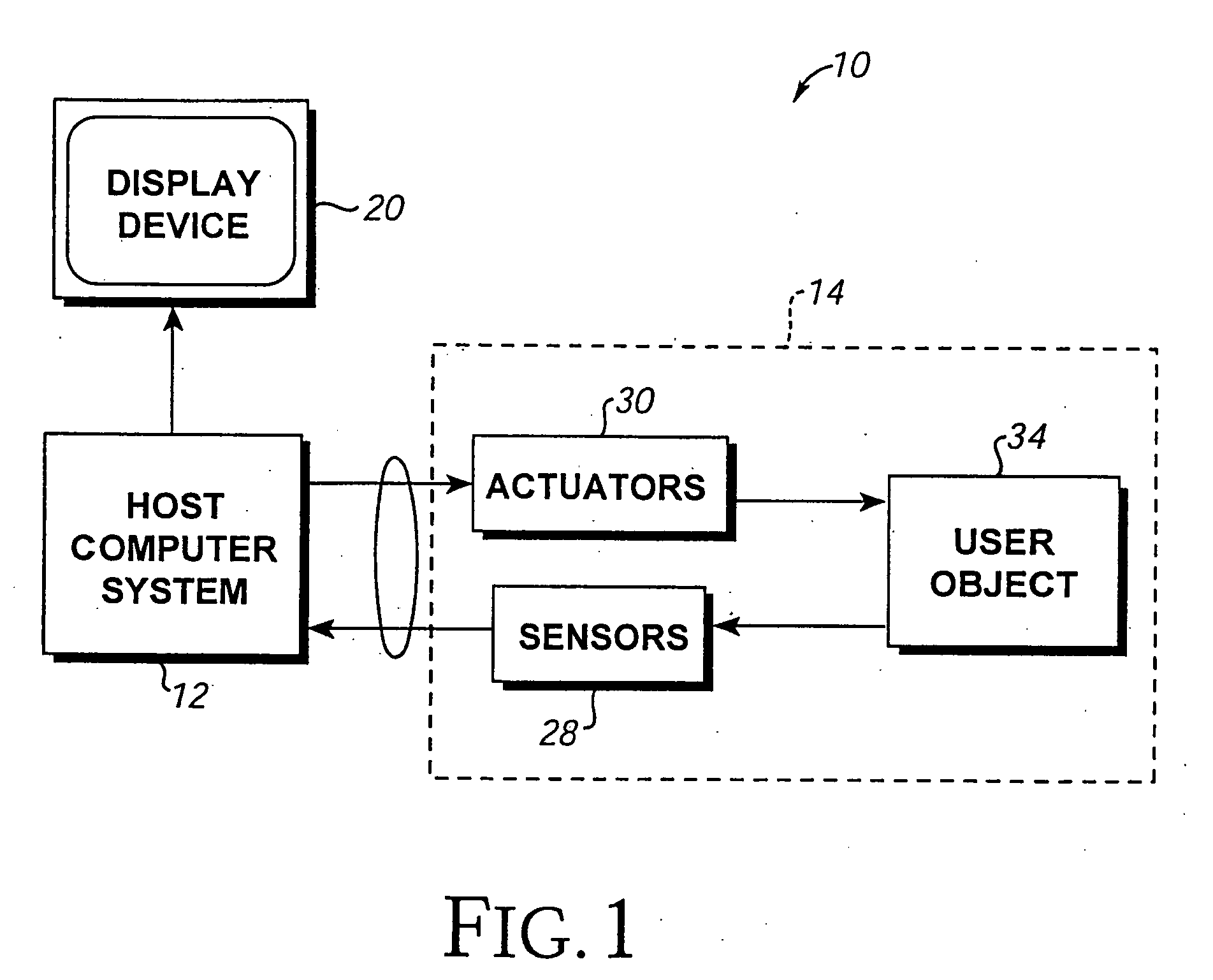Force feedback device for simulating combat
a feedback device and combat technology, applied in the field of interface systems, can solve the problems of not providing a means of presenting physical information back to the user, affecting the effect of realism, and affecting the effect of realism, and achieve the effect of more immersive experien
- Summary
- Abstract
- Description
- Claims
- Application Information
AI Technical Summary
Benefits of technology
Problems solved by technology
Method used
Image
Examples
first embodiment
[0042]FIG. 1 illustrates a block diagram of a control system 10 having a host-controlled control loop in the system to generate force sensations to the user through direct computer control, and which is suitable for use in the present invention. An interface device 14 is used by the user to interface with a host computer 12 which implements a simulation, game, or other application program, as described in greater detail below. Host computer 12 has a display device 20 which displays simulated objects in the simulation controlled by the host computer. The host computer, interface device, and display device are described in greater detail with respect to FIG. 2.
[0043] A “sporting simulation” or “sporting environment” is often referred to herein. These terms are intended to refer to a game, simulation, or similar interaction of a user with a computer which allows the user to use physical skill in the interactions. More specifically, these terms can refer to interactive simulations that ...
second embodiment
[0100]FIG. 4 is a flow diagram illustrating a method 100 for controlling a force feedback interface device. Method 100 is directed to a “reflex” embodiment, in which host computer system 12 provides high-level supervisory force commands (“host commands”) to microprocessor 26 of interface device 14, while the microprocessor independently determines and provides low-level force commands (force values) to actuators 30 as an independent “reflex” to control forces output by the actuators. In other embodiments not including microprocessor 26, method 100 can be used by providing logic or other components to perform the microprocessor steps.
[0101] The process of FIG. 4 is suitable for low speed communication interfaces, such as a standard RS-232 serial interface. However, the embodiment of FIG. 4 is also suitable for high speed communication interfaces such as USB, since the local microprocessor relieves computational burden from host processor 16. In addition, this embodiment can provide a...
embodiment 530
[0197]FIG. 15 shows an alternative embodiment 530 of the game apparatus of the present invention. Game apparatus 530 includes a two-dimensional display 531 in place of the dual displays 504 and 504′ of FIG. 14. In this embodiment, the players can view on a single screen a view of the playing area, paddles, and “puck” from a position directly above the playing area. Game apparatus 530 is thus well-suited for implementing a paddle-ball style game and similar games as described above in the third-person perspective as shown in FIG. 5a.
[0198]FIG. 16 shows an alternative embodiment 535 of the game apparatus of the present invention in which display 528 is replaced with a projected display. A projector 533 which is supported by arm 534 can be provided to project an image onto the area 532 of the game apparatus. For example, when implementing the paddle-ball game described above, the playing field, paddles, and “puck” are projected on the area shown generally at 532 from projector 533. Pr...
PUM
 Login to View More
Login to View More Abstract
Description
Claims
Application Information
 Login to View More
Login to View More - R&D
- Intellectual Property
- Life Sciences
- Materials
- Tech Scout
- Unparalleled Data Quality
- Higher Quality Content
- 60% Fewer Hallucinations
Browse by: Latest US Patents, China's latest patents, Technical Efficacy Thesaurus, Application Domain, Technology Topic, Popular Technical Reports.
© 2025 PatSnap. All rights reserved.Legal|Privacy policy|Modern Slavery Act Transparency Statement|Sitemap|About US| Contact US: help@patsnap.com



